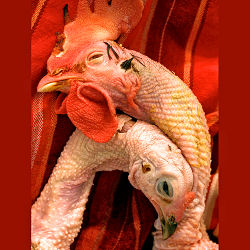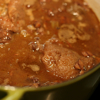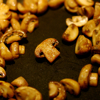A poultry love story
 Have I mentioned lately how much I love the farmers who keep us fed? Even when I’ve done something utterly short-sighted, they managed to swoop in and save me from my own culinary stupidity.
Have I mentioned lately how much I love the farmers who keep us fed? Even when I’ve done something utterly short-sighted, they managed to swoop in and save me from my own culinary stupidity.
Last week, Cameron came up from the basement and announced that somehow we’d run out of chicken stock. “That’s impossible,” I replied. “We had gallons…” A quick trip down the stairs showed that he was right. GULP!
Given that our source of pastured, local chickens dried up before Thanksgiving and that I didn’t really do anything to prepare for this eventuality other than making my usual batches when the bone-bag filled up, I guess I am lucky to have made it this far into winter without running dry. But how could we survive months without a local source of one of our most necessary staples?
After three grocery stops, I finally managed to find local, organic chicken backs. Unfortunately, the Rosie chicken parts that Whole Foods carries come from factory organic farms — they’re local, technically, and ‘free range’, technically, but they’re not really my idea of humane, ethical meat. Unless I wanted to go without stock until spring, I was going to have to choose the lesser of various evils. I went home chickenless and annoyed at my lack of planning.
Two days later, whatever deity watches over locavores and other fools swooped in to save my bacon:
From: Cara, Marin Sun Farms
Subj: Range Hens & RoostersRange hens and range roosters will be offered this weekend at our Farmer’s Markets and Butcher Shop in Point Reyes Station on a first come first serve basis.
I could hardly believe my eyes: pastured chickens, in February? We’ll take two, please. They weren’t cheap — one rooster and one hen tapped out our protein budget for the week (and then some). But they were there, and that’s all that mattered to me and the other folks who swarmed the stand as the market opened.
It turns out that these sturdy birds were no spring chickens [groan!]. Happy by-products of Marin Sun Farms’ egg production, they’re easily double the size of the birds we buy in the spring and summer.
If you think you’re smugly immune to the grim realities of chicken butchery after a summer of dainty heads and tiny feet, you’ve got another thing coming when your supper greets you with an open-eyed stare. And cutting big birds into parts is no trauma-free event, either. Like most other creatures, chickens’ bones and tendons firm up as they mature. The simple shears-and-boning-knife operation required to part out a 3-month-old fryer is a walk in the park compared with the hatchet-job required to take apart a full-grown rooster — and I have the torn-up hands to prove it.
Even if these birds hadn’t been freakishly large, their long, narrow breasts would be a dead giveaway. Barely more than one serving of white meat per bird, these bony chests make an almost-comical sight paired with long, rangy legs. “They look like chickens that tried out for the basketball team,” quipped Cameron.
Mature fowl are best cooked low and slow; one of the MSF farmers was telling folks at the stand that he’d made an exploratory batch of fried chicken, just to see, and… well, no surprise, he didn’t recommend anything but the soup pot or a long, slow stew for any of these tough old birds. (See how many American idioms come from our agricultural roots?)
Of course, any grandma will tell you that modern factory chicken doesn’t taste like it did in the olden days, and much of that has to do with the fact that today’s chickens are slaughtered well before they’re adolescent, much less geriatric. As early as the 1960s, full-fledged stewing chickens were hard enough to come by that even Julia was calling for a measly 2-1/2 to 3-pound fryer for her coq au vin.
Thankfully, we found a lovingly thorough recipe — avec un vrai coq — in our new copy of the River Cottage Meat Book, Hugh Fearnley-Whittingstall‘s ode to sustainable eating in all its carnivorous glory. “They might be scrawny and … on the tough side” says our man Hugh, “But with a diet comprising largely natural forage, by god they’d be tasty.”
Not that I’d ever gainsay a meat maven like Mister F-W, but old-man rooster was definitely an acquired taste, even if you’re used to the “more-chickeny” flavors of pastured meat. Don’t get me wrong: The flavor it lent to the sauce was truly unparallelled — an unctuous, meaty taste that felt in all ways more like beef stew than anything poultry based. As for the meat itself, I liked it when I ate it in the small pieces that flecked the sauce, but the larger chunks were a tad too gamey for my girly palate. Cameron, however, gobbled his bowl while making little moaning noises, so chacun à son goût. For the leftovers, I shredded the meat and put it back in the sauce; served over pasta like a ragu, the flavor was perfect.
Oh, and the backs, wings, feet, heads, and other sundry bits made 12 glorious quarts of golden stock. Our freezer is chock-full of delicious homemade goodness once more. And if that’s not true love, baby, I don’t know what is.
Coq au Vin
— adapted from the River Cottage Meat Book
1 stewing chicken, ideally a farmyard rooster*
1/4 cup butter
1T olive oil
8 ounces pancetta or bacon, cut into large chunks
8 ounces onions, cut into quarters
1/3 cup all-purpose flour, seasoned with salt and pepper
4 oz brandy
2 cups red wine
2 cups chicken stock
bouquet garni of parsley stalks, bay leaf, and thyme
4 celery stalks, cut into 1-1/2-inch lengths
4 garlic cloves, smashed
2 cups canned chopped tomatoes
—
6 to 8 carrots, cut into 1-1/2-inch pieces
1/2 pound white button mushrooms, halved or quartered depending on size
4 to 8 ounces small onions (such as cippolini or pearl), peeled and trimmed
Preheat the oven to 250°F. Cut the chicken into 4 serving pieces, reserving the neck, back, and wingtips (and feet and head, if available) for stock. Heat the butter and oil in a large ovenproof casserole. Fry the bacon pieces in the butter/oil until browned, and remove to a plate with a slotted spoon. Lightly brown the onions in the same pan, and likewise remove them to the plate.
In a paper bag, shake the chicken pieces with the seasoned flour until coated, tapping them against the side of the bag to remove any excess. Brown the dredged chicken in the bacon-butter-oil, working in batches if necessary so as not to crowd the pan, and turning to brown all sides properly. If you’ve worked in batches, return all the chicken parts to the casserole. Pour the brandy over the chicken and (very, very carefully) flame it with a long-handled match. When the flames die down, remove the chicken to the plate with the onions and bacon.
Add the red wine to the casserole, scraping the bottom and sides of the pan to remove any stuck-on bits. Add the stock to the pan and heat to a simmer. Then return the bacon, onions, and chicken to the pan along with the herbs, celery, garlic, and tomatoes. Bring to a gentle simmer. Cover and cook in the oven for 2 to 2-1/2 hours (more like 1-1/2 hours for a younger chicken) until the meat is completely tender.
When you’re within a half-hour of serving time, saute the mushrooms in a bit of olive oil. Please resist the temptation to salt them until they are browned and delicious — you will get a much firmer, tastier mushroom. Meanwhile, in a small frying pan, gently cook the carrots and onions in a shallow layer of water, turning them occasionally and removing them from the pan when they’re just cooked through.
When the chicken is ready, check the consistency of the sauce. If you have a very tight-fitting casserole lid, and/or a wimpy chicken, you may need to reduce the liquid by as much as half of its volume. (Leave the chicken and vegetables in the covered casserole, and reduce the sauce in a separate pan.) Once your pan sauce is thick enough to coat the back of a spoon, put everything together — chicken, vegetables, mushrooms, and sauce — and bring back just to a gentle simmer.
Adjust seasonings to taste, and serve with your favorite mashed potatoes or herbed new potatoes.
* If no roosters are available, HF-W recommends substituting the legs, wings, neck, and giblets of a good free-range turkey, leaving the breast to be roasted another day.









Comment by Food Rockz Man
This post rockz! Such a beautiful, romantic photo . . . in a totally creepy sort of way. I love it! And I really appreciate your passion for poultry . . . from the homemade stock to the pastured birds . . . to your apt description of the butchering process. I hear you on all counts.
Posted on 02.14.08 at 7:18AM
Comment by Lauren
I cried when I saw these photos. No thank you.
Posted on 02.14.08 at 7:53AM
Comment by Anita
FRM: Thanks much!
Lauren: I don’t want to seem insensitve, and I’m sorry that the photos were upsetting. But… where do you think chicken meat comes from? Do you think the boneless, skinless nuggets at Safeway didn’t have heads at one point? Using as much of the chicken as we can is the best way I can imagine to honor the life of the bird and the dedication of the farmer.
Posted on 02.14.08 at 8:03AM
Comment by Jennifer Hess
Fabulous post and photos. Isn’t it amazing how quickly you can go through chicken stock when it’s the yummy homemade variety? Glad you were able to rebuild your stash!
Posted on 02.14.08 at 8:11AM
Comment by Laura
Beautiful photos Anita! It is amazing what a difference good stock makes. I’ve got a bag of roaster carcasses in the freezer just waiting to be made into stock when I get a chance. It will need to be soon since we’ve almost blown through all the chicken and turkey stock in the freezer.
In a twisted sort of way I’m now anticipating the first time we get to eat one of our girls. We’ve got some seriously scrawny free range heritage birds in our freezer. I think I’ll use your recipe to cook a couple of them this weekend before I start packing the kitchen.
Posted on 02.14.08 at 8:45AM
Comment by cookiecrumb
You got 12 quarts?? OMG.
Nice to hear about eating your rooster. 😀
Posted on 02.14.08 at 11:41AM
Comment by Terry B
Anita, great post and photos. Your photo of the birds brings home that our meat does indeed come from creatures. The best way to honor them is to prepare good food, as you have done, and truly enjoy it.
On a more practical note, I’ve often read that coq au vin is best made the day before you plan to serve it to let the flavors swap around overnight.
Posted on 02.14.08 at 12:28PM
Comment by Anita
Jennifer: Oh yeah, homemade stock is pretty much a given for us; I can’t remember the last time I used the premade kind. We go through it like, um, butter. 🙂
Laura: I actually thought of you a lot — especially as I took the photos — wondering if you were planning to eat your girls when they reached the end of their laying days. There’s something satisfying about knowing this rooster was a byproduct (one way or another) of the pastured eggs we eat nearly every day.
The rooster was so handsome, I just couldn’t put him in the pot without some sort of record of his striking appearance. But I did take note of how much harder it is to butcher an eyes-open barnyard rooster than a head-off, feet-off Rosie. And I can only imagine how hard it would be if that beautiful bird had been one that you’d dutifully tended for years, as you do.
Cookie: Yeah, that was some alchemy, as I only put 8 quarts of water in the pot. I think I may even have enough to share…
Terry: Thanks for the sweet comment, and the reminder about the overnight rest. We actually did just that — I made the stew over the weekend and we had it for dinner Monday night. In fact, that’s how we do most of our braises… they’re always always better the next day.
Posted on 02.14.08 at 12:35PM
Comment by Cindy
I love that picture,
It’s unique!
Posted on 02.14.08 at 6:27PM
Comment by jill
I’m a vegan, so I wouldn’t eat this, but I have to say, your response to Lauren was right on par.
If people choose to consume meat, so be it, as long as they make educated decisions about doing so. Pretending that the meat on your plate was never alive is not only disrespectful, but dangerous. I really respect your outlook.
Posted on 02.14.08 at 9:29PM
Comment by Lauren
I just wanted to comment and make sure that people know the Lauren above is not me – the Lauren from Seattle, that is.
And to say Happy Birthday to Anita!
Posted on 02.15.08 at 12:58PM
Pingback by Fickle Pixel » Valentines
[…] via Married with Dinner’s Flickr set. […]
Posted on 02.15.08 at 3:23PM
Comment by Anita
Cindy: Thanks!
Jill: Thank you so much for your comment. People keep asking me if I am getting hate-mail from vegans on that pic, and I love telling them that at least one thoughtful vegan has commented positively. It’s the sentimental omnivores that seem to have the issues — oh, the irony.
Lauren: Well, *I* knew it wasn’t you, but I am glad you clarified for the others. 🙂 And thanks for blowing my secret.
Posted on 02.15.08 at 4:24PM
Comment by Tartelette
Your post reminded me of the gal who used to drive by our house every friday with her game. Chickens well taken care of are built like marathon runners! Although I like gamey meat, I don’t like gamey chickens or turkeys. Thanks for a true to the fact and bone post!
Posted on 02.15.08 at 9:16PM
Comment by Tartelette
Happy Birthday!
Posted on 02.15.08 at 9:19PM
Comment by Diane
Great post! I must admit you are far better than I in your bird choice. I cannot go without stock at hand, and as I have a small freezer only make a 2 gallons at a time or so. So I make it every month or so throughout the year. I use what birds I can find. Always organic. Pastured where I can get it. Feet an absolute must without fail.
Posted on 02.15.08 at 10:32PM
Comment by Sean
Coq à doux de doux! I can almost taste the unctuous stock just reading this. Mmmm … cocky.
Posted on 02.17.08 at 9:18AM
Comment by Walter Jeffries
Hens work too… 🙂 This is a close approximation of how we eat a great many of our older (pastured) hens. I can’t seem to raise the hybrid meat birds but I enjoy chicken so this does it for us. Lots of soup too. It gets us through those long winters up here in Vermont.
Posted on 02.18.08 at 2:03PM
Comment by AmyE
I just finished eating a version of coq au vin that I made for diner tonight! I couldn’t find a rooster (which is why it was a version of coq au vin). I used a cooks illustrated recipe that was adapted for modern chickens rather than roosters. I am completely obsessed with cooks illustrated lately! Anyway, your post really made me wish I could find a rooster! I actually would have liked to see how you cut into that thing. I got some organic chicken thighs and cut myself just trying to debone those!
Posted on 02.18.08 at 6:03PM
Comment by Anita
Helen — Thank you!
Diane — We’re very lucky to have two freezers. Our main fridge in the kitchen is small, a necessary evil of making the most of our kitchen space during the remodel. But we have a smaller fridge in the basement that we use mostly for keeping extra beer and seltzer cold; the freezer on top if the backstock for pasta sauce, chili, stock, bones, breadcrumbs, curry pastes, and everything else we make in bulk.
Sean: Cocky is as cocky does. 😀
Walter: Oh, I have no doubt hens work just fine in this one. I can’t wait to try it with the one we have in the freezer.
Amy E: Right after I posted this, I was reading a recipe in a very old cookbook that suggested parboiling the bird and then cutting it. I bet that would help loosen up tendons and soften keelbones, eh?
Posted on 02.20.08 at 8:16AM
Comment by The Yummy Mummy Cooks Gourmet
Okay, that picture made me spit out my tea. Bravo!…Now, I need to go change my shirt.
And I’m making this recipe. I can just imagine the kids will be all over this. It’s exactly what I was looking for.
Thanks!
Kim
Posted on 02.21.08 at 10:11AM
Comment by The Yummy Mummy
Anita –
Thanks for commenting on my post…and especially for being a good sport!
I have to tell you that you genuinely inspire me to be more ambitious about cooking. From the moment you posted the Coq I was bound and determined to make it and that’s because of your excellent food writing. You really made me NEED to eat it. So thanks for that.
And really, thanks for getting the joke. I was going to e-mail you today to give you a heads up…
Kim
Posted on 03.05.08 at 7:29AM
Comment by Anita
Kim: Thank you so much for the sweet comment — really. It’s hard to nurse my funky mood when you say thinks like that.
I must be the ultimate good sport, because I didn’t even realize I was being teased 😉
In all seriousness, though: I have vast admiration for any mom who puts real food on the table and doesn’t resort to prefab crap on a regular basis. It’s hard enough getting dinner on the table every night when it’s just the two of us… you’ve got double the mouths, double the food issues, and ten times more distractions. And your coq au vin looked scrumptious, flambeed or not! 😀
Posted on 03.05.08 at 10:51AM
Pingback by Married …with dinner » Blog Archive » Out to pasture
[…] I knew well enough we wouldn’t see any chickens slaughtered that Sunday — it happens on Thursdays, anyway, and the oldest of this season’s broilers were still a week from market, merrily clucking away in the pasture. Nothing had been slaughtered here since the old roosters and hens had come to market last winter; the killing place smelled of nothing but the hillside around us. And yet, it had the undeniable air of purpose. I won’t insult you by saying it felt holy, but I do know that there was no nervous laughter, no chatter, no wandering off to investigate something more interesting around the corner. Every one of us on that tour, kids included, was completely present there, standing inside the boundaries of the place where animals became food: The place where each bird experiences what David calls its “one bad day” on the farm. […]
Posted on 04.06.08 at 9:04PM
Pingback by (not so) Urban Hennery » Blog Archive » A Tale of Two Roosters
[…] We opted to invite friends for dinner and test out Anita’s coq au vin recipe. I meant to take photos through the whole process, but it was 85+ degrees and humid and I wanted to get done and get the pots in the oven as fast as possible. I ended up using one pot for the sauteing and browning, but cooking in two pots, my dutch oven and a casserole as I had more chicken than either could handle. I also forgot to weigh the birds, but I would guess that Felix was about 4 pounds and Steve closer to 6. […]
Posted on 08.17.08 at 10:09PM
Pingback by Married …with dinner » Blog Archive » 40 days with my freezer
[…] I sat down and quickly mapped out 14 meals we could easily make by combining two or more components of the freezer. (Beef plus chorizo plus buns equals Sloppy Joes. Beans plus pork plus sausage equals Cassoulet.) And that wasn’t even counting the dozen or so ready-to-eat meals — like beef stew, coq au vin, and chili — that we’d set aside. I quickly realized we could go for weeks, eating very well without buying anything but fresh vegetables. […]
Posted on 03.11.09 at 11:50AM